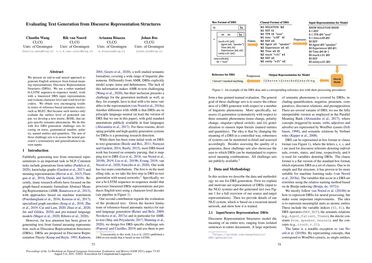Evaluating Text Generation from Discourse Representation Structures
We present an end-to-end neural approach to generate English sentences from formal meaning representations, Discourse Representation Structures (DRSs). We use a rather standard bi-LSTM sequence-to-sequence model, work with a linearized DRS input representation, and evaluate character-level and word-level decoders. We obtain very encouraging results in terms of reference-based automatic metrics such as BLEU. But because such metrics only evaluate the surface level of generated output, we develop a new metric, ROSE, that targets specific semantic phenomena. We do this with five DRS generation challenge sets focusing on tense, grammatical number, polarity, named entities and quantities. The aim of these challenge sets is to assess the neural generator’s systematicity and generalization to unseen inputs.
PDF Abstract
